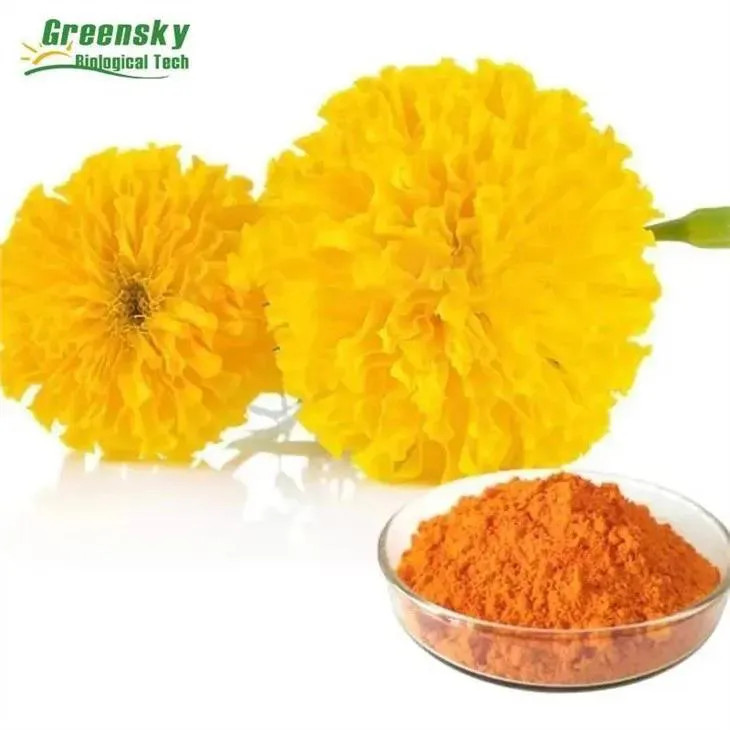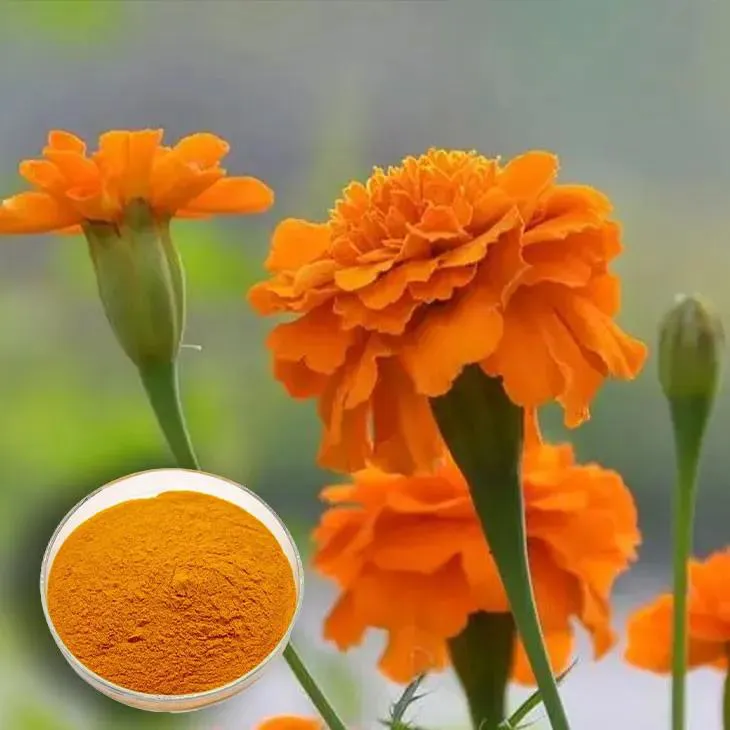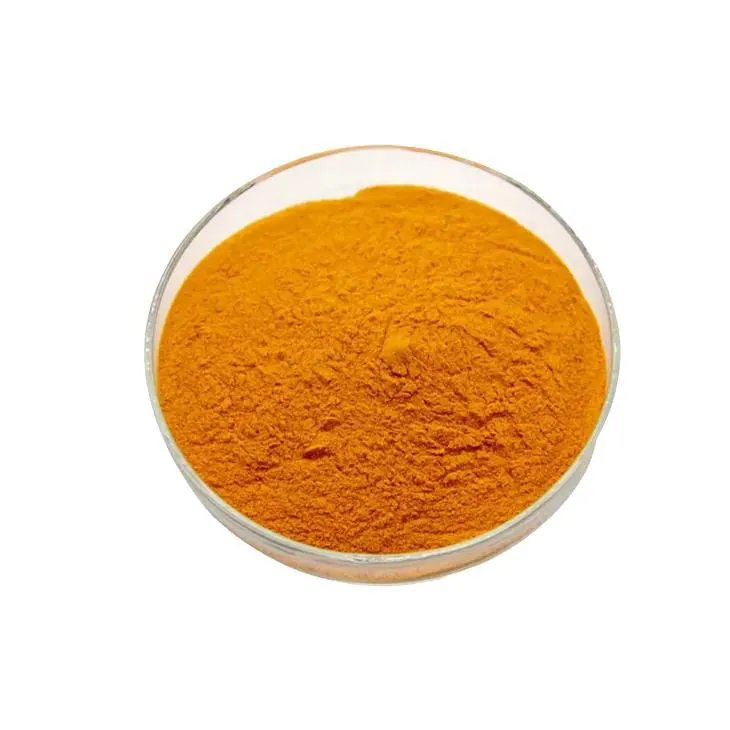- 0086-571-85302990
- sales@greenskybio.com
Optimal Bioavailability of Marigold Extract.
2024-11-30

1. Introduction
Marigold Extract has been increasingly recognized for its potential health benefits due to its rich composition of various bioactive compounds. However, the bioavailability of these compounds is a crucial factor that determines their effectiveness in vivo. Bioavailability refers to the fraction of an administered drug or supplement that reaches the systemic circulation and is available at the site of action. Understanding and optimizing the bioavailability of Marigold Extract can enhance its therapeutic and nutraceutical applications.

2. Chemical Components in Marigold Extract
Marigold extract contains a diverse range of chemical components. Flavonoids are one of the major groups present. These include Quercetin, kaempferol, and luteolin derivatives. Flavonoids are known for their antioxidant, anti - inflammatory, and anti - microbial properties. Another important component is carotenoids, especially lutein and zeaxanthin. These carotenoids are crucial for eye health, as they are concentrated in the macula of the eye and help protect against age - related macular degeneration.
Triterpenoids are also found in marigold extract. These compounds may have anti - cancer and anti - diabetic properties. Additionally, marigold extract contains phenolic acids such as caffeic acid and chlorogenic acid, which contribute to its overall antioxidant activity.

3. Extraction Methods and Their Impact on Bioavailability
3.1 Solvent Extraction
Solvent extraction is a commonly used method for obtaining marigold extract. Different solvents can be used, such as ethanol, methanol, and hexane. Ethanol extraction is often preferred as it can effectively extract both flavonoids and carotenoids. The polarity of the solvent can influence the extraction yield and the composition of the extract. A solvent with appropriate polarity can dissolve a wider range of compounds, thus potentially increasing the bioavailability of the extract. For example, if the solvent is too non - polar, it may not be able to extract polar flavonoids efficiently, and if it is too polar, it may cause degradation of some carotenoids during extraction.
3.2 Supercritical Fluid Extraction
Supercritical fluid extraction (SFE), using carbon dioxide as the supercritical fluid, has several advantages. It is a clean and green extraction method. Since carbon dioxide is non - toxic and easily removed from the extract, there is no residue of harmful solvents. SFE can also selectively extract different components based on the pressure and temperature conditions. This can result in an extract with a more targeted composition, which may enhance the bioavailability of specific components. For instance, by adjusting the SFE parameters, it is possible to preferentially extract lutein, which is highly bioactive and important for eye health.

4. Formulation and Bioavailability
4.1 Nanoparticle Formulation
Nanoparticle formulation has emerged as a promising strategy to improve the bioavailability of marigold extract. By encapsulating the active compounds in nanoparticles, their solubility can be enhanced. Nanoparticles can protect the compounds from degradation in the gastrointestinal tract and improve their absorption across the intestinal barrier. For example, liposomal nanoparticles can encapsulate carotenoids from marigold extract. The lipid bilayer of the liposome can mimic the cell membrane, facilitating the uptake of the encapsulated compounds by cells. Moreover, nanoparticles can also target specific tissues or cells in the body, increasing the concentration of the active compounds at the site of action.
4.2 Emulsion Formulation
Emulsion formulation is another approach to enhance bioavailability. An emulsion consists of two immiscible phases, usually oil and water, with an emulsifier to stabilize the system. In the case of marigold extract, emulsions can be used to solubilize hydrophobic components such as carotenoids. The emulsifier can reduce the surface tension between the oil and water phases, allowing for better dispersion of the extract. This can lead to improved absorption in the gut, as the emulsified extract has a larger surface area for interaction with the absorptive cells in the intestine.

5. Interaction with the Body
5.1 Absorption in the Gastrointestinal Tract
The absorption of marigold extract in the gastrointestinal tract is a complex process. Flavonoids are generally absorbed in the small intestine through passive diffusion and active transport mechanisms. The presence of certain transporters, such as glucose transporters, can facilitate the uptake of flavonoid - glycosides. For carotenoids, they need to be released from the food matrix and emulsified in the gut lumen before they can be absorbed. The bile salts play an important role in this emulsification process. Once emulsified, carotenoids can be taken up by enterocytes through a process that may involve scavenger receptor class B type I (SR - BI).
5.2 Metabolism in the Body
After absorption, the components of marigold extract undergo metabolism in the body. Flavonoids are metabolized mainly in the liver and intestine. They can be conjugated with glucuronic acid, sulfate, or methyl groups. These metabolic modifications can affect their bioactivity and bioavailability. For example, conjugation may increase their water solubility, which can influence their excretion or further distribution in the body. Carotenoids are also metabolized, and some can be converted into vitamin A in the body. However, the efficiency of this conversion can vary depending on factors such as the individual's diet and health status.
5.3 Distribution and Excretion
The distribution of marigold extract components in the body is determined by their physicochemical properties. Lipophilic compounds such as carotenoids tend to be distributed to lipid - rich tissues such as adipose tissue and the retina. Water - soluble metabolites of flavonoids are more likely to be distributed in the aqueous compartments of the body. The excretion of these compounds occurs mainly through the kidneys (for water - soluble metabolites) and the feces (for unabsorbed or biliary - excreted compounds). The rate of excretion can also affect the overall bioavailability, as a faster excretion rate means a shorter time for the compounds to exert their effects in the body.
6. Strategies for Maximizing Bioavailability
To maximize the bioavailability of marigold extract, several strategies can be employed:
- Optimize the extraction method: Select the most appropriate extraction method based on the target components. For example, if the goal is to obtain a high - quality carotenoid - rich extract, supercritical fluid extraction may be a better choice.
- Formulate smartly: Develop nanoparticle or emulsion formulations to enhance solubility and absorption. These formulations can protect the active compounds from degradation and improve their delivery to the target sites.
- Consider co - administration with other substances: Some substances can enhance the absorption or metabolism of marigold extract components. For example, certain fats can improve the absorption of carotenoids. Co - administration of marigold extract with appropriate fats may increase its bioavailability.
7. Conclusion
In conclusion, optimizing the bioavailability of marigold extract is essential for fully realizing its potential health benefits. By understanding the chemical components, extraction methods, formulation, and interaction with the body, it is possible to develop strategies to enhance the bioavailability of marigold extract. Future research should focus on further exploring these factors and developing more effective and targeted approaches to maximize the bioavailability of marigold extract in various applications, whether in the field of nutraceuticals, pharmaceuticals, or cosmetics.
FAQ:
Question 1: What are the common extraction methods of marigold extract?
There are several common extraction methods for marigold extract. One is solvent extraction, which often uses solvents like ethanol or hexane to dissolve the active components from the marigold. Another method is supercritical fluid extraction, typically using carbon dioxide in a supercritical state. This method can be more selective and often results in a purer extract compared to traditional solvent extraction.
Question 2: How does the formulation affect the bioavailability of marigold extract?
The formulation plays a crucial role in the bioavailability of marigold extract. For example, if it is formulated in a capsule, the type of capsule material and its dissolution properties can impact how quickly the extract is released in the body. A formulation that protects the active components from degradation in the stomach and promotes their absorption in the intestines can enhance bioavailability. Additionally, combining the marigold extract with certain carriers or adjuvants in the formulation can also improve its absorption.
Question 3: Which chemical components in marigold extract are most important for bioavailability?
Flavonoids and carotenoids are among the important chemical components in marigold extract related to bioavailability. Flavonoids can have antioxidant properties and may influence the absorption and metabolism processes in the body. Carotenoids, such as lutein and zeaxanthin, are well - known for their potential health benefits. Their chemical structures and solubilities can affect how they are absorbed in the gastrointestinal tract and utilized by the body.
Question 4: How does the body interact with marigold extract during absorption?
During absorption, the marigold extract first encounters the digestive system. The stomach's acidic environment can affect the stability of some components. In the intestines, specific transporters may be involved in taking up the active components of the marigold extract. For example, some lipid - soluble components may be absorbed along with dietary fats through lipid - mediated transport mechanisms. Once absorbed, these components may be further metabolized in the liver or other tissues.
Question 5: Can food or other substances interact with marigold extract to affect its bioavailability?
Yes, food and other substances can interact with marigold extract to affect its bioavailability. For instance, if consumed with a high - fat meal, the fat can enhance the absorption of lipid - soluble components in the marigold extract. On the other hand, certain medications may interact with the marigold extract. For example, drugs that affect liver metabolism may alter the way the body processes the extract, either increasing or decreasing its bioavailability.
Related literature
- Bioavailability of Marigold Extract Components: A Review"
- "Optimizing the Bioavailability of Marigold - Derived Compounds for Therapeutic Applications"
- "The Role of Formulation in Enhancing Marigold Extract Bioavailability"
- ▶ Hesperidin
- ▶ citrus bioflavonoids
- ▶ plant extract
- ▶ lycopene
- ▶ Diosmin
- ▶ Grape seed extract
- ▶ Sea buckthorn Juice Powder
- ▶ Beetroot powder
- ▶ Hops Extract
- ▶ Artichoke Extract
- ▶ Reishi mushroom extract
- ▶ Astaxanthin
- ▶ Green Tea Extract
- ▶ Curcumin Extract
- ▶ Horse Chestnut Extract
- ▶ Other Problems
- ▶ Boswellia Serrata Extract
- ▶ Resveratrol Extract
- ▶ Marigold Extract
- ▶ Grape Leaf Extract
- ▶ blog3
- ▶ blog4
-
Super Essence of Natural Lotus Leaf Extract.
2024-11-30
-
Chinese Sea - buckthorn Oil Manufacturers.
2024-11-30
-
The best organic L - arginine.
2024-11-30
-
How to make powder from yam extract?
2024-11-30
-
Camu Camu Extract
2024-11-30
-
Sea buckthorn Juice Powder
2024-11-30
-
Hedyotis Diffusa Extract
2024-11-30
-
Grape Seed Extract
2024-11-30
-
Dandelion Leaf Extract
2024-11-30
-
Tormentil Extract
2024-11-30
-
Shikonin
2024-11-30
-
Lavender Extract
2024-11-30
-
Aminolevulinic acid
2024-11-30
-
Longan Extract
2024-11-30





















